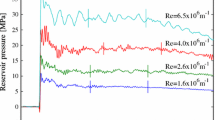Abstract.
A method for visualizing streaklines in hypervelocity flows has been developed. The method uses the high temperatures produced in hypervelocity flows to ablate small amounts of sodium deposited onto a wire stretched across the flow and to broaden the lines in the sodium spectrum. By using a dye laser, tuned to a wavelength close to one of the sodium D-lines, as the light source in shadowgraph or Schlieren visualization, streaklines seeded with sodium become visible through absorption and/or enhanced refractivity. The technique has been used to investigate the stability of the shear layer produced by the curved bow shock on a cylindrically blunted wedge. The results suggest that the shear layer is unstable, exhibiting structures with a wavelength that is comparable to half the nose radius of the body.
Similar content being viewed by others
Author information
Authors and Affiliations
Additional information
Electronic Publication
Rights and permissions
About this article
Cite this article
Lemieux, .P., Hornung, .H. Development and application of streakline visualization in hypervelocity flows. Exp Fluids 33, 188–195 (2002). https://doi.org/10.1007/s00348-002-0433-8
Received:
Accepted:
Issue Date:
DOI: https://doi.org/10.1007/s00348-002-0433-8




